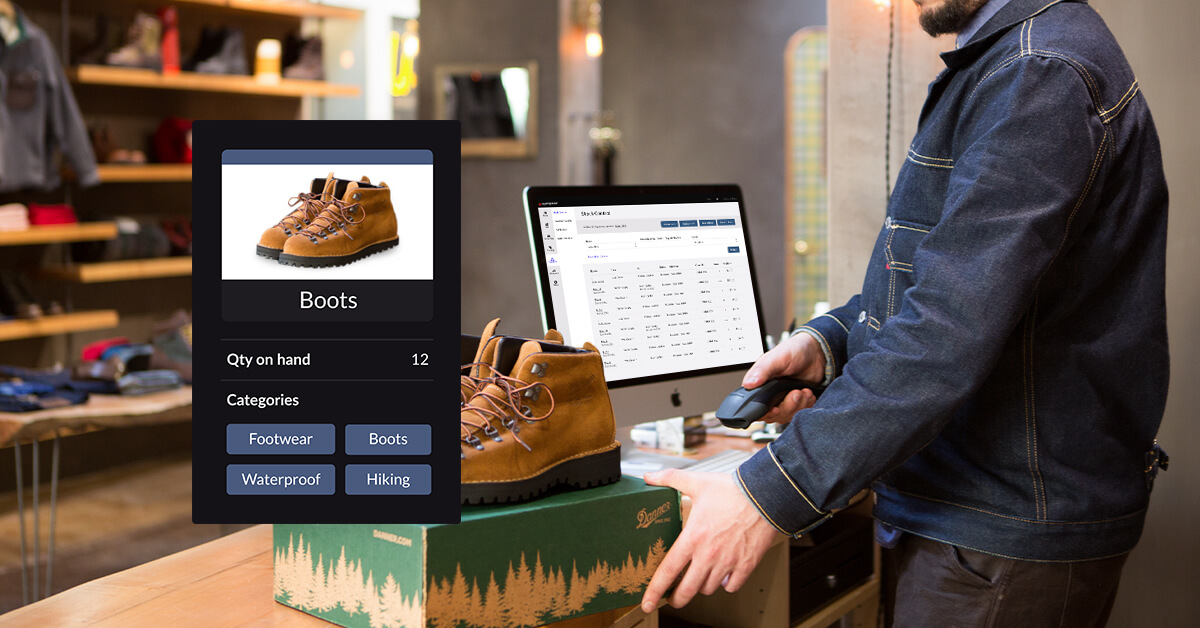
Your inventory management is an integral part of your business and one of the processes you have the most control over. Lax inventory control can lead to stockouts, over-ordering and a dent in profits. Therefore, taking the time to optimise your current workflows will lead to increased efficiency and, in many cases, a boost in sales.
Overhauling your inventory management can seem daunting, but it doesn’t have to be. We’ve identified five easy-to-implement tips that you can use to optimise your current inventory management processes so you can save time, improve productivity and increase sales.
Let’s dive in.
- Audit your inventory
- Optimise your reporting
- Sync product data directly from suppliers
- Set reorder points for all your inventory
- Use inventory management software
1. Audit your inventory
If you’re serious about optimising your inventory management, starting with a clean slate is essential. While you might believe your inventory levels are correct on paper, it’s vital to sense-check your current stock numbers by conducting a physical stocktake.
Orchestrating an inventory audit can be time-consuming, but ensuring your numbers are accurate is crucial and will provide a solid foundation to successfully optimise your inventory processes.
Once you’ve conducted your inventory audit, you’ll be in the perfect position to optimise your inventory management – but this shouldn’t be the only physical stocktake you do.
Setting time aside to conduct physical inventory counts throughout the year is crucial to ensure your data reflects what you have in stock. This reduces the likelihood of discrepancies, which can lead to overstocking or understocking, impacting customer satisfaction and profitability.
Regular physical inventory audits foster a culture of continuous improvement within your business. They provide an opportunity to identify areas for enhancement in inventory management processes, technology, training, and overall operations.
Aside from these benefits, how else will regular inventory audits help your business?
Validate your data
Regular physical audits help validate the accuracy of data recorded in your inventory management software. This ensures that decisions based on this data, such as reorder points, safety stock levels, and demand forecasting, are reliable and effective.
Uncover process inefficiencies
Physical audits can uncover process inefficiencies within the inventory management system. For example, if certain items are consistently misplaced or missing, it could indicate issues with inventory tracking, employee training, or stocking procedures. Identifying these inefficiencies will allow you to implement corrective measures.
Another example is identifying shrinkage. Shrinkage refers to losses in inventory due to theft, damage, or administrative errors. You can identify and quantify shrinkage accurately by conducting regular physical audits and then implementing strategies to minimise losses and improve profitability.
Optimise replenishment strategies and strategic decision-making
Accurate inventory audits will empower you to fine-tune your replenishment strategies. With exact numbers, it will be easier to avoid over-ordering, which ties up capital and storage space, or under-ordering, which leads to stockouts. This optimisation will improve your cash flow and enhance the customer experience by ensuring your products are available when customers want them.
Plus, accurate inventory data provides insights into product performance, demand trends, and seasonal fluctuations. This information is vital for making informed strategic decisions about product assortment, pricing, promotions, and discontinuations.
In a nutshell, a physical inventory audit is the first fundamental step for any retail store seeking to optimise its inventory management processes. Accurate inventory data serves as the cornerstone for efficient operations, better decision-making, improved financial management, and enhanced customer experiences.

2. Optimising reporting
How well do you know your inventory?
While many retailers can give a ballpark estimate of their stock levels and what sells well, relying on educated guesses can lead to trouble down the track.
To really understand how your inventory is performing, you need analytics. Most POS systems contain a wealth of information on your products, so harnessing this data to optimise your inventory management is crucial.
Diving into your data can be overwhelming, but understanding your analytics often isn’t as difficult as you might think. Your POS is already tracking a lot of your inventory and sales data; you just need to ensure you’re capturing and utilising it in a meaningful way.
Must-have inventory reports
Inventory reports are crucial for retail businesses because they provide valuable insights into the status of their inventory, sales, and overall operations. These reports help retailers make informed decisions, optimise inventory management strategies, and enhance business performance.
Here are ten inventory reports your retail businesses might find helpful:
- Stock report: provides a snapshot of the current stock levels for each product, helping you understand what items are in stock, on order, and backorder.
- Sales analysis report: analyses sales data alongside inventory levels to identify trends, fast-moving items, slow-moving items, and potential stockouts.
- Stock turnover report: calculates the rate at which inventory is sold and replenished. It helps assess inventory management efficiency and identify which products contribute most to turnover.
- ABC analysis report:categorises items into A, B, and C groups based on their contribution to revenue. It guides focus on high-value products and efficient management of lower-value items.
- Reorder point report: determines the inventory level at which a new order should be placed to prevent stockouts before the next order arrives.
- Safety stock report: calculates a buffer for unexpected demand fluctuations or supplier delays. This report estimates the ideal safety stock levels for different products.
- Deadstock report: highlights items that have not sold within a specified period. It helps identify products that need to be marked down or removed from inventory.
- Supplier performance report: evaluates the performance of suppliers based on factors like lead times, order accuracy, and product quality.
- Forecast accuracy report: if retailers use demand forecasting, this report assesses the accuracy of forecasts compared to actual sales. It helps refine forecasting methods and improve inventory planning.
- Stock ageing report: useful for products with expiration dates; this report categorises inventory by age, helping manage items that need to be sold or disposed of soon.
By utilising these inventory reports, retailers can gain insights into their inventory processes that support informed decision-making, streamline operations, minimise costs, and enhance customer satisfaction.
Remember: your business may only need to use some of these reports. The exact reports your store might need will depend on the specific requirements of your business and the types of products you deal with.
Why are inventory reports important?
Inventory reports provide accurate and up-to-date information about stock levels, turnover rates, and demand patterns. In turn, this information empowers you to make data-driven decisions regarding purchasing, pricing, restocking, and inventory optimisation.
Inventory insights are also essential to identify potential risks, such as overstocking, understocking, or slow-moving items. By recognising these risks early on, you can take corrective actions to prevent financial losses and maintain healthy inventory levels in your store.
As well as ensuring a smoother inventory management workflow, inventory reports can help you pinpoint sales trends, seasonal variations, and customer preferences. This information will guide your inventory planning and help align your product offering with customer demands.

3. Sync product data directly from suppliers
One of the main benefits of optimising your inventory management is boosting efficiency so you can save time on menial tasks and reinvest these hours into your business.
A great way to do this is to sync your product data from your suppliers to your POS. This will make adding new inventory to your POS faster and ensure accuracy as you’re pulling information directly from a centralised supplier database.
Lightspeed NuORDER makes updating product information quick and easy, allowing you to access thousands of brands across numerous categories to automate your product information.
From apparel and footwear brands to bikes, sporting goods and toys, Lightspeed NuORDER makes it simple to import product data supplied from the brand, including UPC, MSRP, description, image and name.
Thanks to Lightspeed NuORDER, you’ll no longer have to type in product data for all your items manually. Instead, you can simply search for a product in the platform and add it to your system.
Automatically syncing your product data makes your inventory management more efficient and has several other benefits for your business.
- Easy-to-use search tools built into your POS make it quick and easy to search products by names, keywords or UPC and add them to your system – saving you and your team time and effort.
- Digitally adding new products that automatically sync with your POS means you’ll never miss a sale, as you can quickly add new inventory to your system in just a few clicks.
- Syncing product data directly from your suppliers to your POS ensures accuracy, so you always have confidence in your product information.
- Eliminating the need to manually manage data or stock orders will boost your team’s efficiency, and they can reinvest their time focusing on your customers or other areas of your business.
4. Set reorder points for all your inventory
Setting reorder points for your inventory is a surefire way to make your life a whole lot easier. After all, optimising your inventory management is all about saving you and your team time by making your current processes more efficient.
With reorder points, you’ll assign every item in your store a minimum threshold. Once you’ve sold enough of a particular item and hit the minimum threshold, your POS will alert you that you’re running low, prompting you to place a purchase order.
How will implementing reorder points benefit your business?
Setting up reorder points for your products offers several benefits that contribute to efficient inventory management and smoother operations. Reorder points help ensure you have the right amount of inventory to meet customer demand while minimising stockouts and overstocking.
But that’s not all; there are several other key benefits of using reorder points:
- Maintain optimal inventory levels: Reorder points are usually calculated based on factors like lead time and sales velocity to ensure you have enough inventory to cover the time it takes for a new order to arrive. This means you’ll avoid accumulating excess inventory by ensuring that new stock is ordered only when needed.
- Streamline purchasing: Reorder points provide a clear trigger for when to initiate a purchase order, reducing the need for manual intervention, as orders are automatically generated when inventory levels reach the reorder point.
- Reduce wasted space: By maintaining inventory levels based on reorder points, you can optimise your storage space and make better use of available resources.
Setting up reorder points for your inventory helps strike a balance between supply and demand. It allows you to optimise your inventory levels, reducing costs and improving overall operational efficiency in the process.

5. Use inventory management software
Choosing the right inventory management software is one of the most important things you can do to reduce the complexity of your inventory management.
Inventory management software provides the tools to optimise your inventory processes, reduce costs, improve customer service, and make informed decisions that contribute to your business’s success.
Plus, having an all-in-one solution like Lightspeed means you can manage everything from your day-to-day sales to payment processing and inventory management from one centralised system.
What are the benefits of using inventory management software?
There are several reasons why a retail store should use inventory management software, as it offers a range of benefits that significantly improve efficiency, accuracy, and overall operations.
Accurate inventory tracking and in-depth analytics
Manual data entry isn’t foolproof. Even the most meticulous staff make mistakes and are prone to human error. Therefore, inventory management software eliminates the risk of data entry errors and ensures that information is recorded accurately.
As all of your inventory is logged in the system, you’ll also be able to track inventory levels in real-time, ensuring you know exactly how much stock your store has at any moment. This accuracy reduces the risk of overstocking, stockouts, and discrepancies between records and actual stock.
With all this information in one place, it’s easy to generate various reports that provide insights into sales trends, stock performance, supplier performance, and more to guide your strategic decision-making.
These insights also empower you to continually optimise your inventory management processes, as it’s easy to identify fast-moving items, slow-moving items, and those that require attention.
Efficient order management
Inventory management software enables streamlined order processing, from order creation to fulfilment. It helps automate the order workflow, reducing manual errors and ensuring that orders are fulfilled accurately and on time.
As we touched on earlier, it’s also possible to set up and manage reorder points and automatically generate POs when inventory levels drop to a specified threshold – saving you time and minimising the risk of your products being out of stock.
Many software solutions also offer demand forecasting capabilities by analysing historical data and trends. This helps retailers make more accurate predictions about future demand, allowing for better inventory planning.
To understand the valuable insights into the principles and practices of effective inventory management, check out our resource on What Is Inventory Management.
Features to look for
To ensure you’ll get the most from your inventory management software, ensure it has the following features.
- Real-time visibility of all inventory, so staff can accurately see your inventory on hand even through heavy sales days.
- Easy inventory transfers between locations (bonus points for tracking inventory in transit) so that you can easily move products between your stores.
- Comprehensive stock reporting that can break down sales by location so you can make informed buying decisions.
- Alert notifications when an item is running low or if there is a much higher sell-through rate than usual, so you don’t need to monitor your inventory constantly.
- Reorder points and amounts for staple items when they hit a certain low point to save time and prevent those popular seasonless items from going out of stock.
These days, the right inventory management system can take on the brunt of your inventory-related tasks, no matter if you’re managing one store or many. With inventory monitoring and some re-ordering taken care of, what remains is for you to make merchandising decisions based on your inventory reports and manage your stock on the ground.

News you care about. Tips you can use.
Everything your business needs to grow, delivered straight to your inbox.


